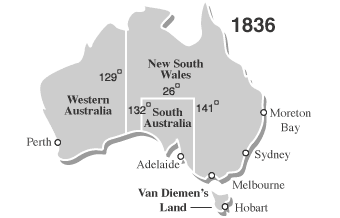
Australian colony boundaries, 1836. Source: Civics and Citizenship Education, Discovering Democracy Units
Aoife O’Brien ~ Rachelle Laman ~ Robert Agar
The first European colonies of Australia were penal colonies: settlements used to remove prisoners to a remote location separate from the general population. These penal colonies later developed into free colonies. However, the colony of South Australia did not develop in the same way as it was the first planned colony, authorised by an Act of Parliament (An Act to empower His Majesty to erect South Australia into a British Province or Provinces, and to provide for the Colonization and Government thereof) in 1834.[1]

Edward Gibbon Wakefield (1796-1862)
The South Australian colony, and its capital Adelaide, provide an interesting study of the Irish immigrant experience that differs to that of the other colonies. The colony was developed following the systematic colonisation policies of Edward Gibbon Wakefield. In 1829, Wakefield had outlined the three most important principles of governance needed in a new settlement. The first of these were to replace the granting of free land with setting a fair price for unoccupied land. Second was to use the profit made on the sale of land to fund the emigration of voluntary settlers that met the requirements of the colony in regards to age, gender and skills. The third principle was that a colony should gain independent governance once their population reached 50,000.[2]
The general Irish immigrant experience of employment is noteworthy precisely because South Australia was the first planned colony. The Irish dealt with several issues distinct to the colony that hindered their ability to find satisfactory employment, particularly in Adelaide. Indeed, Roman Catholic immigration to the colony was at first restricted as the colony’s administration wished to engineer a Protestant society. Thus, the Irish made up a minimal portion of the population of Adelaide in its formative years which made it increasingly difficult for them to integrate into the established community once they did begin to arrive. An increase came about following the lifting of restrictions on the admittance of Catholics in the 1850s.
Another factor that impacted the Irish immigrants’ ability to prosper in Adelaide was their lack of skills that were required in the colony. The hurdles Irish immigrants had to overcome when settling in Adelaide proved too much for many. The struggles that they experienced with regard to employment and education had further reaching effects – a disproportionate amount of them were committed to mental institutions over the course of the nineteenth century. As public asylums were introduced they became ‘dumping grounds’ for those who could not keep up with the fast-paced new society around them. The Irish arriving in Adelaide appear to have fallen into this category more than other social group – predominantly because they were among the poorest immigrants entering South Australia during a period in which there was a correlation between proximity to the poverty line and admittance to a mental institution.
Nevertheless, the Irish of Adelaide played a role in the building of the city through their work on public buildings while Irish manual labourers contributed to the construction of Catholic churches throughout the colony of South Australia. This served to both progress the development of the colony while at the same time providing the Irish with a place within the community. A number of these labourers were also involved in the establishment of railroads in South Australia which made the colony more accessible and aided the movement of people and resources.
REFERENCES
[1] South Australia Act, or Foundation Act, of 1834 (UK), Documenting a Democracy, Museum of Australian Democracy at Old Parliament House (http://www.foundingdocs.gov.au/item-did-1.html) (15 May 2017)
[2] E.G. Wakefield, A Letter from Sydney: The principal town of Australasia (London, 1829).